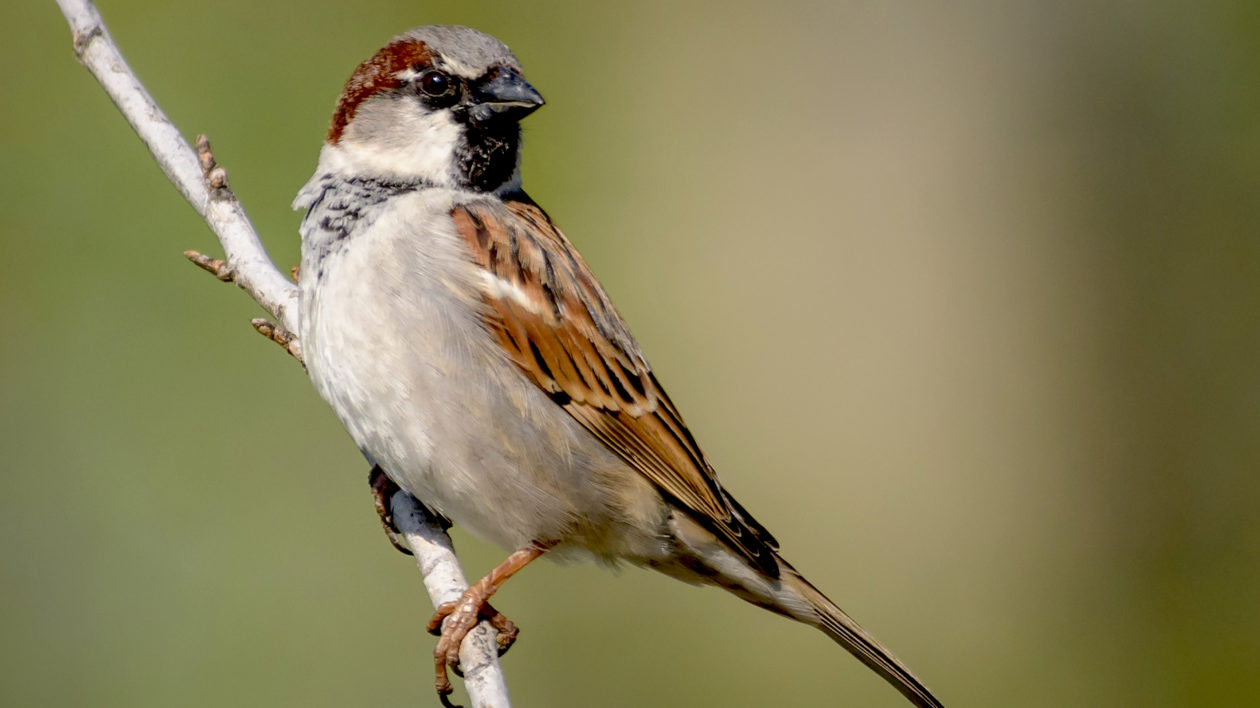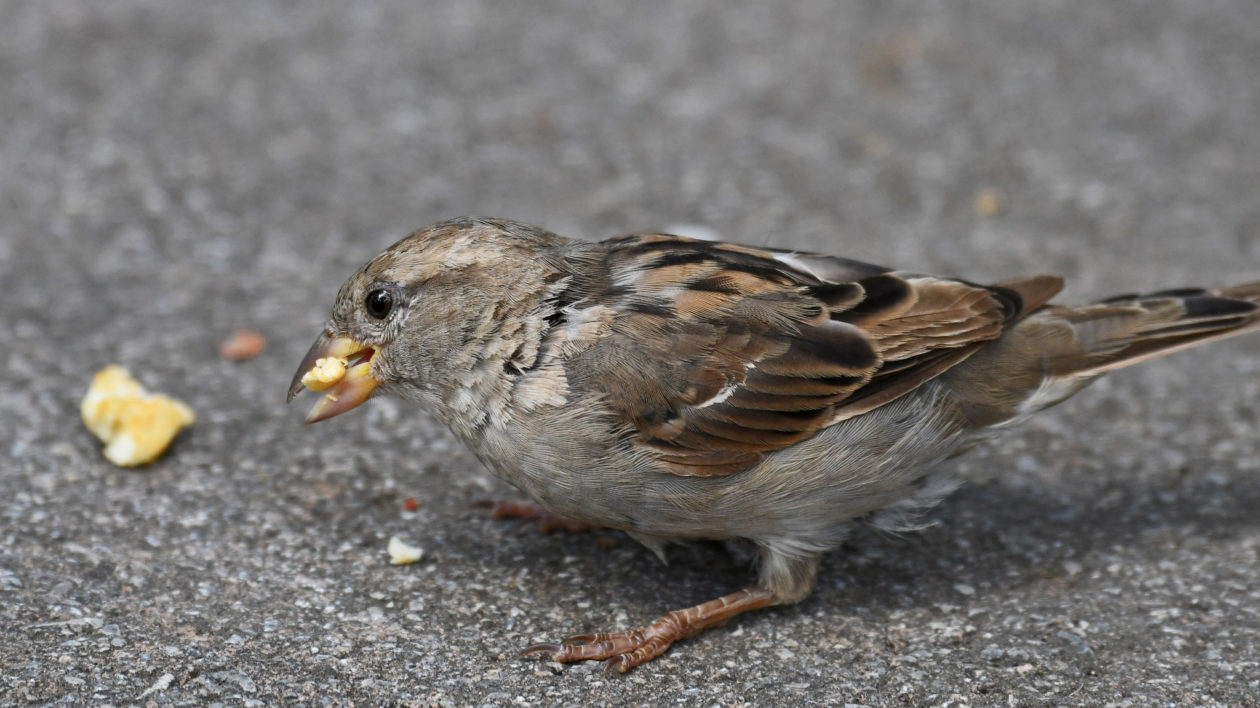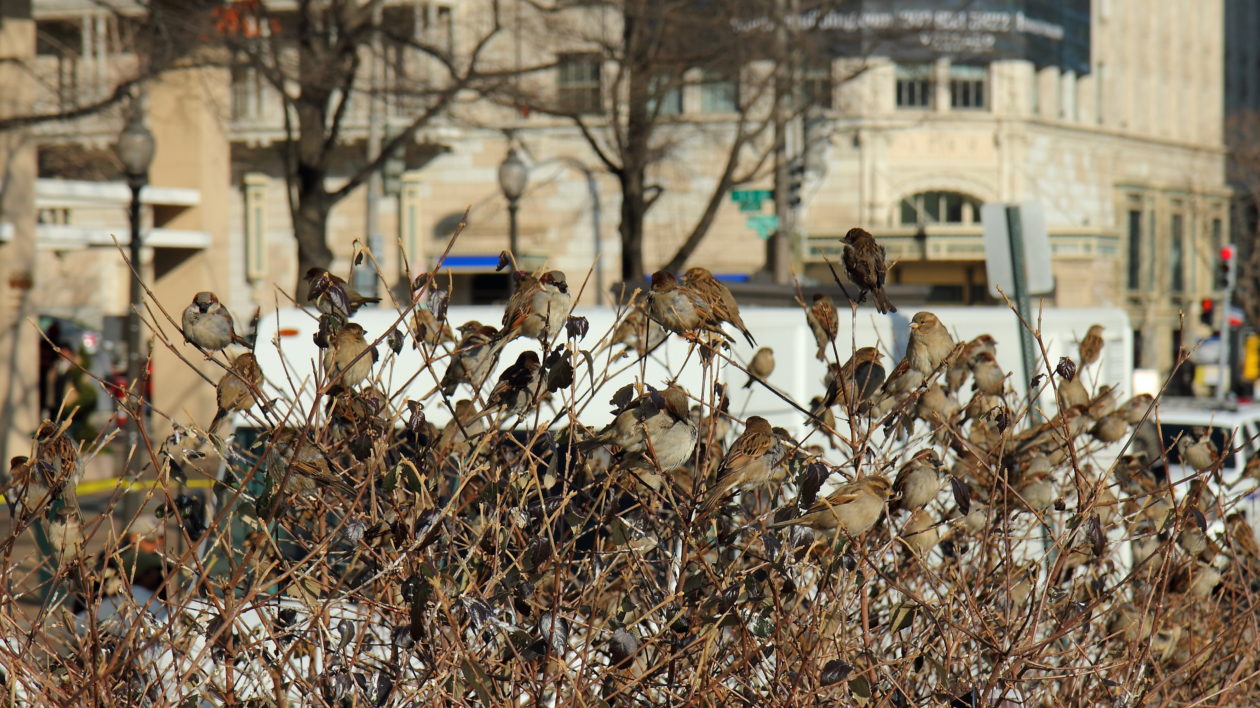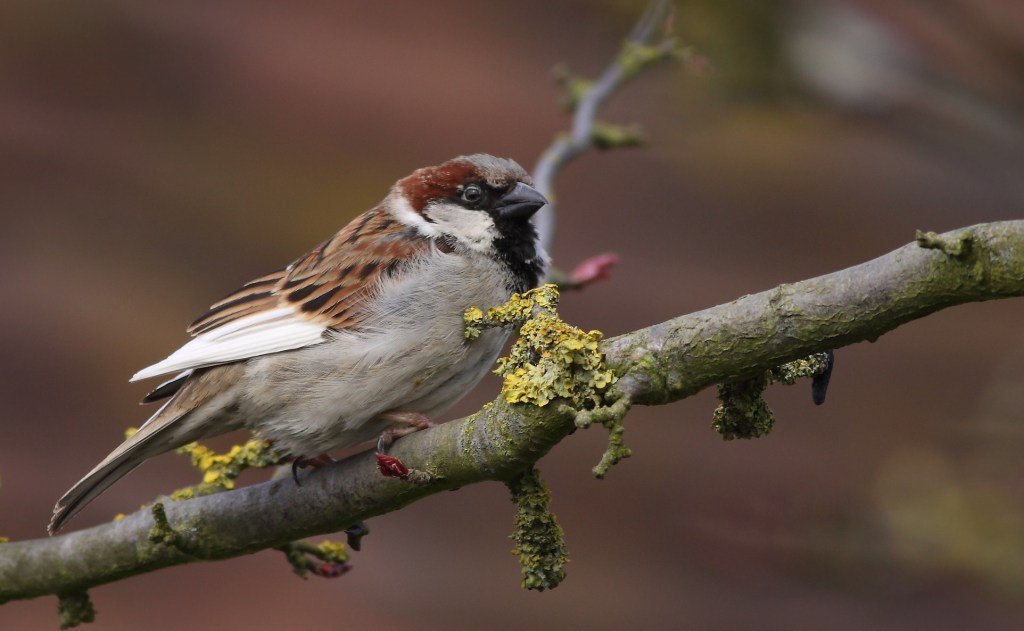I look out my window, and they’re everywhere: hundreds of house sparrows flit around our shrubs, hop around the yard, and steal food from our backyard chickens.
At this time of year, the males puff up and display, making them appear like much larger birds. They cheep incessantly, often drowning out other birdsong.
Given their constant presence, it seems odd to be writing this: House sparrow populations have been declining worldwide, including in their native range.
House sparrows are often considered one of the most adaptable birds, capable of thriving amongst our farms, suburbs and cities. The real story of their spread and decline is a bit more complex, and may have implications for urban conservation.
The Sparrow Fad
The house sparrow (Passer domesticus) is native to Eurasia, but beginning in the mid-1800s, it spread around the globe. Largely due to intentional releases by humans, house sparrows are now found on every continent except Antarctica, as well as many islands. It is the most widespread wild bird on earth.
As with many aspects of conservation history, many of the details of sparrow introductions are poorly documented. The first introduction to North America was to New York City in 1851 or 1852, although the 8 pairs released seemed to fare poorly. However, this set off a wave of introductions throughout the United States.
For a time, some sources refer to a “sparrow fad,” with private individuals breeding birds, and others catching them and releasing them into new areas. Nest boxes were installed in cities to increase sparrow populations. Ornithologists and others raised concerns over the merits of house sparrows, but their arguments proved futile against sparrow enthusiasts releasing cages full of birds.
The reason for many of these reasons was for pest control. For instance, their 1868 introduction to Philadelphia was apparently an effort to control inchworms. As with so many such pest control efforts, the cure proved worse than the disease. They thrive on a variety of foods, including spilled grain and even garbage.
The house sparrow is also an aggressive little bird. It nests in cavities, and pushed out native species like Eastern bluebirds. Backyard birders who erect birdhouses have undoubtedly noticed house sparrows bullying wrens and other native species.
Public sentiment turned quickly against the house sparrow. By the 1880s, just three decades after the first introduction, several U.S. cities paid bounties for the birds. But by then the bird was firmly established – and spreading.

Recent research published in the Proceedings of the Royal Society B found that house sparrows underwent genetic changes, including modified skull development and a gene that helps create the enzyme amylase that helps break down starch. The researchers hypothesized that these changes helped sparrows adapt to human settlements dominated by agricultural fields and livestock. The sparrows, according to the research, diverged from other Old World sparrows around 11,000 years ago, just as agriculture was taking hold in the Middle East.
The house sparrow appears to be a clear winner in the Anthropocene: an adaptable bird capable of thriving equally well on cities and in farms.
But over the past few decades, ornithologists have noted a new trend: house sparrows are in widespread decline. According to the Cornell Lab of Ornithology, house sparrow numbers in North America have declined by 84 percent since 1966. In Philadelphia, the city where the sparrows were introduced to control inchworms, the birds have largely disappeared.
Many birders view this as a good-news story. After all, house sparrows compete with native species and are generally viewed as a pest. However, the bird is experiencing similar declines in many parts of its native habitat, including the United Kingdom and Western Europe.
In England, house sparrow populations have declined by half. The species is listed by the Royal Society for the Protection of Birds as a species of high conservation concern. While the United Kingdom population has recently stabilized, the bird remains of concern to conservationists. European countries now recognize a World Sparrow Day to raise awareness of the plight of this once-abundant species.
What happened?

Sparrow Falling
Theories abound as to why house sparrows have declined. The answer likely lies in a combination of factors, all tied to rapid changes in both cities and farms. House sparrows may be highly adaptable, but that doesn’t mean they can thrive with every modification humans make to the environment.
The first house sparrow decline was actually reported in the 1920s, when automobiles began widely replacing horses. Sparrows feasted on the huge amount of spilled grain found in cities. When that food source was removed, sparrow populations decreased.
The Royal Society for the Protection of Birds and others note that changing agricultural practices likely play a significant role in the current sparrow decline. Once, farms were diverse, with crop fields and livestock barns scattered across the landscape. New, clean, intensified monocultures result in less spilled grain, and less cover around fields. In many parts of the world, other birds associated with farmland are also in decline.
Livestock is more frequently raised in confined operations, sometimes even indoors. All this results in fewer opportunities to feed on grain.
Similarly, city sanitary practices have improved, which may make finding meals more difficult for sparrows.
Research published in the journal Frontiers in Ecology and Evolution found that a combination of poor diet and air pollution induced physical stress on house sparrows, leading to reduced reproductive success.
The widely reported global insect decline may also be a significant factor. Many think of house sparrows as vegetarians, gobbling bird seed and grains. But, as with many birds, they rely on protein-rich insects to feed their young.

Implications for Urban Conservation
There are still 540 million house sparrows flying around the planet, so this bird is not in danger of going extinct. It’s still abundant in many places – including my neighborhood, where a mix of native vegetation, bird feeders and backyard chicken coops provide the diversity of habitat and food sources that enables these birds to thrive.
So why is the house sparrow decline important?
In part, it shows how little we understand urban ecology. Even conservationists often assume that common, adaptable species will be able to adapt to any change. That’s clearly not the case.
All ecosystems change, but human environments often change rapidly. If we’re thinking about protecting biodiversity in cities – and in a world that will have 9 billion people, we have to – we have to think about how changes impact wildlife. Just as modification to a tropical forest affects wildlife, so too do changes in farming practices, changes in city design, even changes in bird feeding habits.
I wouldn’t miss the house sparrow from my neighborhood. It’s an invasive species that competes with native birds. But globally, the sparrow’s decline is a story we should heed, as it may help us better understand how to coexist with nature in the Anthropocene.




I live in Philadelphia and I feed in my front yard and back yard.This past winter I had 2 flocks of sparrows numbering 50 sparrows each.
These house sparrows are also called Weaver finches. I, too, enjoy seeing them. The decline of fellow species should draw everyone’s attention. Climate change endanger’s all life and poses the greatest threat facing civilization. Climate change has caused mass extinctions in the past and is contributing to the sixth extinction which we are experiencing. It must be addressed now. Jim Weaver
I noticed many fewer sparrows in our suburban neighborhood in Tidewater , Virginia about ten or more years ago. Sparrows used to be the birds that commonly crowded around the steps of the house. Now I notice many more diverse birds in the neighborhood. Occasional sparrows are still here, but they are not the most common anymore. Now that I have bird feeders, I see many kinds of birds close up and handily identifiable and no longer are they . mosty sparrows.
In my urban neighborhood there used to be pigeons everywhere, not the native type. I,m surprised that the native birds, mourning doves have replaced them. I can’t imagine why. We have lots more robins and they are staying around. I’m not sure about the sparrows. I see more raptors above this spring, too.
Mary Lizie
Shame on you, Matthew, for the unwelcome discussion of the House Sparrow. Do you know how many of these birds have killed our native cavity-nesters, like Eastern Bluebirds, Chickadees, and Tufted Titmice.
The House Sparrow is not native to the U.S. – where it is an alien species. As a member of the Bluebird Society of Pennsylvania I work hard to limit the success of the HOSP. There are still – in a very conservative estimate – about 4 House Sparrows for every 1 bluebird. Your
Hi Marilyn,
Thanks for your comment. I am just reporting on an interesting phenomenon. In fact, in my concluding paragraph, I write “I would not miss the house sparrow from my neighborhood.” The story covers the history of the introduction of the sparrow. And nowhere did I suggest we try to reverse that decline in areas where the sparrow is not native.
The house sparrow is also declining in its native range, which is what makes this an interesting conservation issue. A species most of us in the United States know as invasive, is also a species of conservation concern in the UK and other parts of its native range. Thanks again for taking time to comment. Matt
Why couldn’t this article be reporting on a decline in the Starling population?… I too, am not sad that House Sparrows are in decline.
I do have a few Song Sparrows that infectiously (?) occupy the front of my home – LOVE their song.
I don’t see as many birds In New Hampshire as I have when I lived in Bridgton, Maine. The condo I live in does not allow feeding birds anymore to my dismay.
I use to have a variety of birds it seems they have gone to greener pastures, sadly.
Now I plant as many lupine, coneflowers, daisys, bee balm along with other perennials as I can for all the birds, butterflys and humming birds.
The condo asso has put out some kind of black boxes with poison in then, I am beside myself with this nonsense! Other residence are out spraying roundup because they do not like the danderlions in turn they are killing the grass along with the few bees i have managed to attract. These people don’t realize that poisons are not the answer. I for one would love any type of bird.
A year ago I had a sparrow feeding a large bird I was shocked, everdently a cow bird layed her eggs in a sparrows nest! I have it on video!
Thank you for your interest of wild life, would appreciate any feed back on how to cohabitate with ignorant people who harm our surroundings in nature.
They have moved to Leadville, CO.
William Leon Dawson, author of the four volume Birds of California (1923), wrote:
“Without question the most deplorable event in the history of American ornithology was the introduction of the English Sparrow. The extinction of the Great Auk, the passing of the Wild Pigeon and the Turkey,__sad as these are, they are trifles compared to the wholesale reduction of our smaller birds, which is due to the invasion of this wretched foreigner.”
He lists 9 “charges” against this species, and ends with, “He is vermin and must be treated as such, but give the Devil his due, of course. What are we going to do about it? Wage unceasing warfare, as we do against rats. …..etc, etc… His discussion of the English Sparrow went on for 4 pages..
Your article about this species is very interesting, but I felt compelled to show another viewpoint.
I don’t disagree with Dawson’s viewpoint. Sparrows are invasive in many parts of the world, including where I live. But I find their decline intriguing; it calls to question what we think we know about the adaptability of abundant wildlife. It is especially interesting given that house sparrows are also declining in their native range.
Many thanks for commenting.
Matt
Sparrows are bigger in Texas; seriously.
And they appear to be thriving there
Thank you for caring! In my yard I provide food, shelter and water and places to reproduce. I never use pesticides and continue to ask my neighbors to use other methods.
My yard is full of the songs and my neighbors years are much quieter. If we provide what they need, wildlife will come to the islands of safety!
I would miss them in my Queens, NYC neighborhood. I like to see them taking advantage of any scrap or crumb left behind by people and bathing in a puddle after rain. They add movement and chattering song to an otherwise gray environment.
Sparrows are abundant in Osawatomie,KS where I live. I have seen a clear decline in native song birds here. Cardinals, blue jays, tufted titmouse, doves, cow birds, red wing black birds, wood peckers, this is just a few. What we have an overabundance of is European starlings. We have them in huge family groups. They are taking over the native song bird habitat.
For a period of time a few years ago I noticed that aggressive house finches seemed to be displacing house sparrows. But now the sparrows seem to be making a comeback even tho the finches are still quite prevalent. They appear to be making an accommodation to each other here in urban southern Wisconsin.
Very interesting and informative.